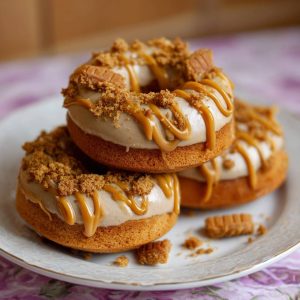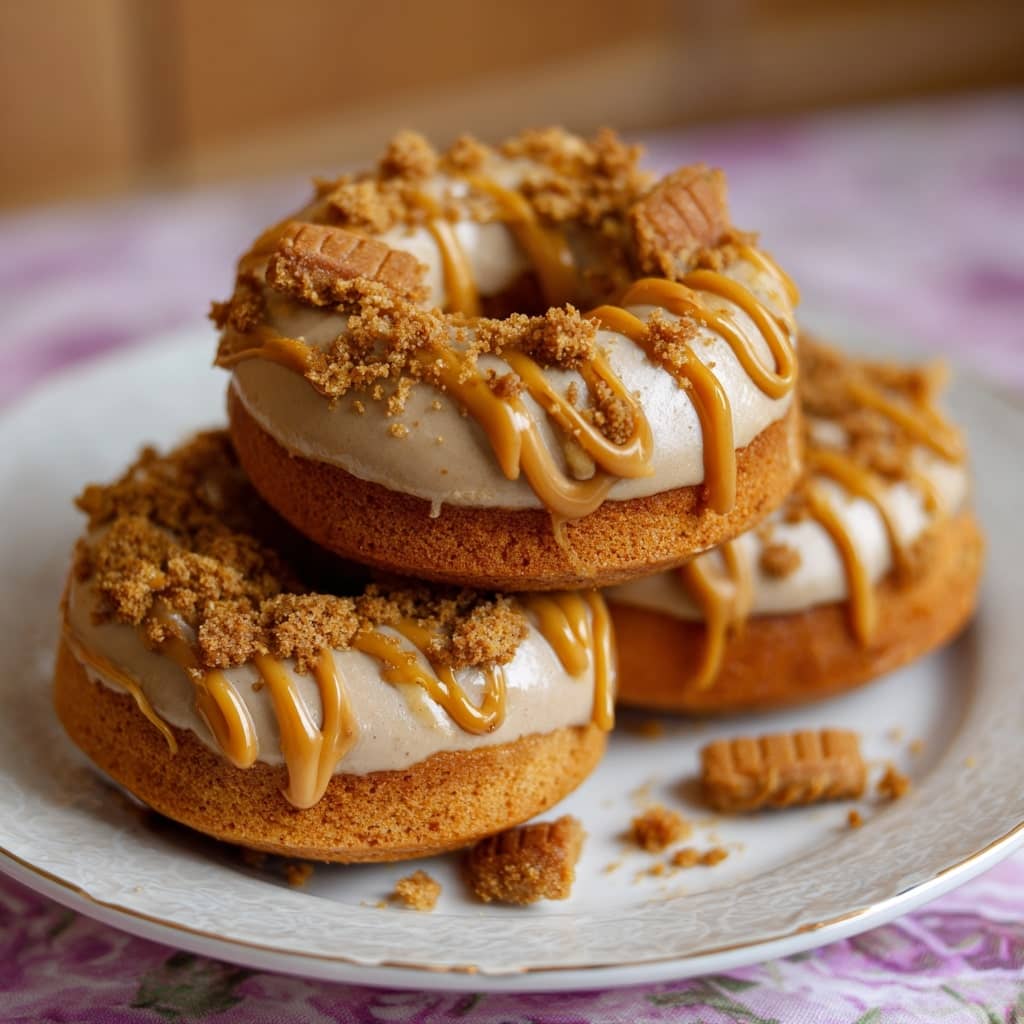Introduction
Biscoff Donuts are a delightful fusion of classic fried or baked donuts with the unique and addictive flavor of Lotus Biscoff spread and biscuits. These treats combine the light, airy texture of donuts with the rich, caramelized spice notes of Biscoff, creating a perfect balance between soft, fluffy dough and crunchy, sweet toppings. Whether glazed, filled, or topped with Biscoff spread and crushed biscuits, these donuts offer an indulgent experience that appeals to cookie butter fans and dessert lovers alike. Perfect for breakfast, snack time, or special occasions, Biscoff Donuts bring a modern twist to a beloved classic and can be enjoyed warm, fresh, or chilled.
The History of Biscoff Donuts
Donuts have a long and varied history, originating as simple fried dough pastries dating back centuries across different cultures, with the iconic ring-shaped donut popularized in America during the 19th and 20th centuries. Meanwhile, Lotus Biscoff biscuits originated in Belgium in the 1930s and gained international fame for their distinctive caramel and cinnamon flavor. The rise of cookie butter in recent years has inspired creative bakers to integrate this beloved spread into a variety of desserts. Biscoff Donuts represent this modern innovation, marrying the traditional donut’s fluffy texture with the sweet, spicy notes of Biscoff, reflecting a global love for fusion flavors and artisanal sweet treats.
Ingredients Breakdown
- 250g plain flour: forms the base structure of the dough.
- 50g sugar: adds sweetness and aids browning.
- 7g instant yeast: helps the dough rise and become fluffy.
- 120ml warm milk: activates the yeast and moistens the dough.
- 1 large egg: binds ingredients and adds richness.
- 50g unsalted butter (softened): adds tenderness and flavor.
- Pinch of salt: balances sweetness and enhances flavor.
- Vegetable oil (for frying) or baking spray (if baking).
- 200g Lotus Biscoff spread: used for glazing, filling, or topping.
- Crushed Lotus Biscoff biscuits: for garnish and added crunch.
- Optional: powdered sugar for dusting or icing sugar for glaze.
Step-by-Step Recipe
- In a large bowl, mix the flour, sugar, instant yeast, and salt.
- Warm the milk slightly (not too hot) and whisk in the egg and softened butter.
- Gradually add the wet ingredients to the dry, mixing until a sticky dough forms.
- Knead the dough on a floured surface for about 8-10 minutes until smooth and elastic.
- Place the dough in a lightly oiled bowl, cover with a damp cloth, and let it rise in a warm place for 1 to 1.5 hours, or until doubled in size.
- Once risen, roll the dough out to about 1 cm thickness and cut out donut shapes with a donut cutter or two round cutters.
- Place the cut donuts on a baking tray lined with parchment paper, cover, and allow them to rise again for about 30-40 minutes.
- Heat vegetable oil in a deep fryer or large pot to 175ºC (350ºF). Fry the donuts a few at a time for 1-2 minutes on each side or until golden brown. Drain on paper towels. Alternatively, bake in a preheated oven at 180ºC (350ºF) for 12-15 minutes until golden.
- While still warm, glaze the donuts with warmed Biscoff spread or dip into a Biscoff glaze made by mixing the spread with a little powdered sugar or milk.
- Sprinkle crushed Biscoff biscuits on top or fill the donuts by piping Biscoff spread inside.
- Serve fresh and enjoy!
Tips for the Perfect Biscoff Donuts
Use fresh yeast or active instant yeast to ensure a good rise. Keep your milk warm but not hot to avoid killing the yeast. Knead the dough thoroughly for elasticity and structure. Don’t overcrowd the fryer to maintain oil temperature and achieve even cooking. Fry until golden and light, not dark, for a soft interior. Warm the Biscoff spread slightly to make glazing easier and smoother. Allow the donuts to cool slightly before glazing to avoid melting the topping too much. For baking, use baking spray or parchment to prevent sticking and check doneness carefully. Customize toppings immediately after glazing for best adhesion.
Variations and Customizations
Try filling the donuts with whipped cream or custard alongside Biscoff spread for extra indulgence. Add cinnamon or nutmeg to the dough for enhanced spice notes. Use dark chocolate or white chocolate ganache instead of Biscoff glaze for contrast. Sprinkle crushed nuts or toasted coconut alongside Biscoff crumbs for texture variety. Experiment with vegan dough recipes and dairy-free Biscoff spreads for dietary needs. Incorporate flavored sugars, such as cinnamon sugar or pumpkin spice, as a finishing touch. Try baked Biscoff donuts for a lighter, less oily option.
Health Considerations and Nutritional Value
Biscoff Donuts are a treat high in sugar, fat, and calories due to the frying process, butter, and sweet toppings. While delicious, they should be enjoyed in moderation, especially by individuals managing blood sugar or weight. Biscoff spread contains sugar and some trans fats, so it’s best to be mindful of portion sizes. Using baked donuts can reduce fat content, and alternative sweeteners may be used to adjust sugar levels. Adding whole grain flour or incorporating seeds can boost fiber content, though this alters the traditional texture. For those with allergies, gluten-free flours and dairy-free spreads are available to adapt the recipe.
FAQ
Can I bake Biscoff Donuts instead of frying? Yes, baking is a healthier alternative and yields a lighter texture.
How do I store leftover donuts? Store in an airtight container at room temperature for 1-2 days; reheat gently before serving.
Can I freeze Biscoff Donuts? Yes, freeze in a sealed bag for up to 2 months; thaw before eating.
Is there a vegan version? Yes, substitute butter with plant-based alternatives and use flax or chia eggs.
Where can I find Lotus Biscoff spread? Most supermarkets and online stores carry it.
Can I fill the donuts with Biscoff spread? Absolutely, just use a piping bag to inject filling after cooking.
What oil is best for frying donuts? Neutral oils with high smoke points like vegetable, sunflower, or canola oil work best.
Can I use gluten-free flour? Yes, but results may vary; consider a blend designed for yeast doughs.

Biscoff Donuts
Ingredients
For the Biscoff Donuts
- 130 g plain flour all-purpose flour (1 cup / about 4½ oz)
- 1 teaspoon baking powder
- ½ teaspoon ground cinnamon
- ⅛ teaspoon salt
- ½ cup light brown sugar 100g / 3½ oz
- ½ cup Biscoff spread 150g / about 5¼ oz
- ½ cup whole milk 125ml
- 1 large egg
- 2 tablespoons vegetable oil 40ml (see notes)
- 1 teaspoon vanilla extract
For the Biscoff Glaze
- ¼ cup Biscoff spread 75g / about 2¾ oz
- 1½ to 2 tablespoons milk 30-40ml (see notes)
- 130 g icing sugar powdered sugar (1 cup / about 4½ oz)
- 1 Biscoff cookie crushed into crumbs
Instructions
- For the Biscoff Donuts: Preheat your oven to 180°C (160°C fan-forced) or 350°F and lightly grease a donut pan with butter (see notes). In a medium bowl, sift together the flour, baking powder, cinnamon, and salt. Add the sugar and whisk everything thoroughly, ensuring there are no lumps. Warm the Biscoff spread in the microwave for 15-20 seconds. Make a well in the center of the dry ingredients and add the Biscoff spread, milk, egg, vegetable oil, and vanilla extract. Using a balloon whisk, break the egg yolk and start mixing the wet ingredients together, then gently fold in the flour mixture until you achieve a thick but pourable batter. Without cutting the tip, place a large piping bag tip-down into a tall glass, fold the top of the bag over the rim, and use your hand to open it up. Pour the batter into the piping bag, then twist the top tightly to prevent batter from escaping. Snip off the tip with scissors and pipe the batter into the donut pan cavities about two-thirds full (see notes). Once piped, gently tap the pan twice on the countertop to release air bubbles, then bake for 9-10 minutes. Let the donuts cool in the pan for 5 minutes before flipping the pan over a wire rack and tapping gently on the edges to release them. Allow them to cool completely before frosting, about 30 minutes.
- For the Biscoff Icing: Warm the Biscoff spread in a medium bowl in the microwave for 15 seconds. Sift the icing sugar over it and add 1 tablespoon of milk. Whisk the mixture well to combine. Add additional milk, one teaspoon at a time, until the glaze is thick but flows back into the bowl within a few seconds after lifting the whisk. If the glaze becomes too thin, add more icing sugar to thicken (see notes). Immediately sprinkle crushed Biscoff cookie crumbs on top. Please take a moment to leave a comment and rating — it’s greatly appreciated and very helpful!

